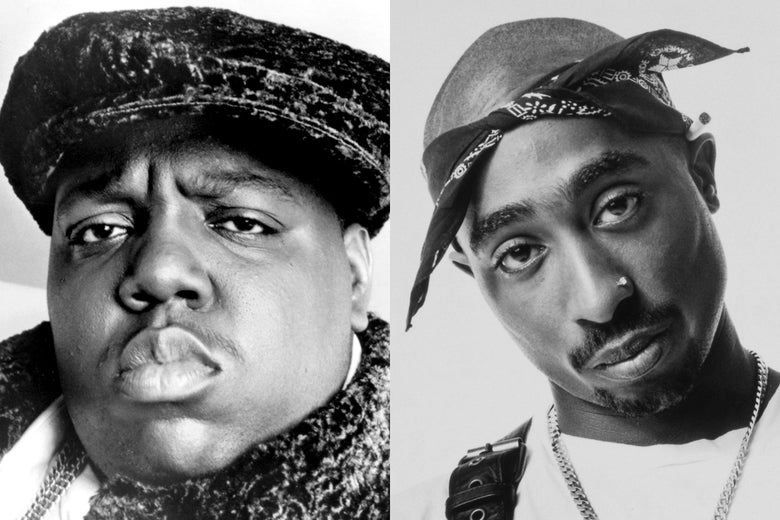
Christopher “Biggie” Wallace and Tupac Shakur.
Photo illustration by Slate. Photos by Michael Levine/Getty Images and Michael O’Neill/Corbis via Getty Images.
It was Nov. 29, 1994, and Tupac Shakur was in trouble.
He was on trial for sexual abuse, sodomy, and weapons possession.
A woman had accused him of setting her up to be raped in his New York hotel room. The jury started deliberating that morning, and Tupac was facing the possibility of a long prison sentence. His career was already suffering, and his legal bills were piling up. Tupac needed cash.
During the trial, Tupac spent his evenings going from one recording studio to another, trying to rap his way out of financial ruin. On the night of Nov. 29, Tupac was cutting a track at Quad Recording Studios in Times Square. Quad was a busy spot. SWV, Mobb Deep, and Deborah Cox were also recording that night. And so was Junior M.A.F.I.A., the rap group started by Christopher Wallace, better known as the Notorious B.I.G. Biggie was in the studio with the rest of his group, including Chico Del Vec. Chico considered Tupac a friend. The same was true of the rest of Biggie’s circle. They looked up to Tupac. They’d welcomed him when he visited Brooklyn. That night at Quad, they showed each other love as he walked into the lobby to record his verse
A few hours later, Tupac left the Quad on a gurney after an apparent hold-up, alive but his body full of bullet holes. When I started reporting on Tupac Shakur and Christopher “Biggie” Wallace a few months ago, there was a lot I didn’t know—about their relationship, where it went wrong, and how their murders changed the course of hip-hop.
But this moment on the gurney: This was one part of their story that I thought I had locked down. There’s this iconic photo, maybe you’ve seen it. It was taken that night outside Quad Studios. Tupac is on a stretcher with a big brace on his head and neck. And he’s sticking up his middle finger.
This photo shows the moment when Tupac and Biggie went from friends to enemies.
He looked angry, at everyone and everything. I always assumed he was flipping the bird at the photographer. That he was pissed off at the media for invading his privacy in this vulnerable moment.
But Chico Del Vec told me I had it wrong: Tupac was giving the finger to Biggie and his crew, who he suspected were involved in the shooting, though there’s little evidence that they were.
“Tupac gets off the elevator, on the hospital bed, they wheeling him out … and he looking at us with his middle finger up,” Del Vec told me. “He was saying, ‘Fuck y’all niggas.’ … looking at us against the wall.”
I told him I’d thought Tupac was flipping off the media.
“No. That was to us!”
Chico was telling me that this was it—this was the moment when allies became enemies. I’d seen the photo, but I hadn’t seen that.
What else had I missed? What else did I need to know to understand who Biggie and Tupac were, and how they’d both ended up dead? That’s what I set out to do on this season of Slow Burn. Over eight episodes, you’ll hear about the creative lives and tragic deaths of two of hip-hop’s foundational talents, from voices and angles you’ve never heard before. You’ll hear about how a friendship gone bad turned into a nationwide turf war. How lyrics about violence blurred into the real thing. And how investigators have failed to solve the murders of two of the 20th century’s most important artists.
This excerpt has been edited for length and clarity. Subscribe to the new season of Slow Burn now on Apple Podcasts, Spotify, Stitcher, or wherever you get your podcasts. And to hear the interviews we just couldn’t fit in the main episodes, join Slate Plus.
Readers like you make our work possible. Help us continue to provide the reporting, commentary and criticism you won’t find anywhere else.
Join Slate Plusfrom Slate Magazine https://ift.tt/2prdLOT
via IFTTT
沒有留言:
張貼留言